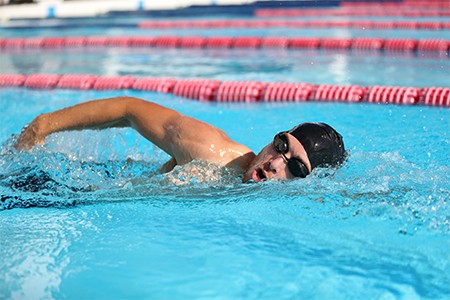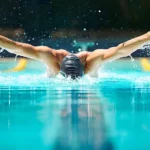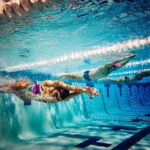If you’re involved in competitive swimming, you know how difficult it can be to tweak…
How to Optimize Breathing When Swimming

It goes without saying that breathing is essential, but in swimming it is a science. It can either amp up your power and propulsion or debilitate your technique when done incorrectly. Coaches often field questions from swimmers such as: “When do I breathe?” “Where do I breathe?” “How many times should I breathe?” All of them are legitimate questions, but the answer is not always so obvious.
There are two options for breathing – (1) through the nose and (2) through the mouth. You’re probably wondering which one is optimal for swimming? Let’s discover more in our SwimMirror blog!
Go Ahead and Exhale
Most swimmers don’t have to be told to inhale, but many must be reminded to exhale. If it takes too long to take a full breath, your breathing can actually slow your stroke rate. It can also lead to increased frontal drag if the breath causes the recovery arm to cross over the body or if the head comes out of the water too much. This is not something a swimmer likes to hear. So, in response many swimmers tend to hold their breath for an extended period of time, but this is a very dangerous tactic.
In order for the muscles to function, oxygen needs to be delivered to the body. Oxygen increases energy and speed for swimmers to keep their pace. As the body uses oxygen, it creates carbon dioxide (CO2). As CO2 builds up in the body, it senses this and the brain tells you that you need to breathe. The out of breath feeling we experience as humans is not from a lack of oxygen, but from an excess of CO2. Swimmers who don’t exhale properly tend to feel winded very quickly, and their muscles fail to recover or function at the same rate. This can cause you to lose your race, or worse can cause injury.
So, go ahead; breathe in and breathe out.
Breathing Through the Nose
Breathing is different when you are swimming – you inhale through your mouth and exhale through your nose. Exhalation while swimming happens under water. It is important to note that exhaling lasts up to two or three times longer than inhaling.
Here are some key tips to optimize your exhalation through your nose:
Breathe out slowly
When you are underwater, you are able to propel yourself forward, so it’s important that you focus on exhaling slowly. Blowing out air too quickly can force you to take a breath when you don’t intend to.
Develop breath control sets
Breath control sets help swimmers attain proper breathing and better lung capacity. Some methods to consider are: (1) holding your breath for an extended period of time or (2) short frequency breathing patterns. Experiment with these tactics regularly, and you will start to feel the difference in your swimming technique and breathing patterns.
Don’t forget to give yourself rest and breaks!
Breathing Through the Mouth
Generally, people are not used to inhaling through their mouths, so swimmers have to constantly train and practice this technique. Proper inhalation will ensure you are swimming at your best.
Here are some tips to improve your inhalation in the water:
Breathe into the “trough”
Many coaches have to teach young swimmers not to lift their heads too far out of the water. Oftentimes, swimmers lift their heads too high to take a breath, and this throws their swimming strokes and kicks off.
There is something known as “the trough”; this refers to the pocket of air right at the surface of the water where, ideally, swimmers should take their breaths. Coaches often have to remind swimmers that the air at the surface is just as good as the air six inches above the water.
SwimMirror is a great tool for helping swimmers train to keep their heads in the water.
[maxbutton id=”5″ ]
Synchronize your breaths and your movements
Remember how we mentioned that breathing in swimming is a science? The reason is that every swimmer is different. Therefore, it is critical to create a continuous pattern of breathing and movement that produces the best technique.
For instance, the crawl breathing technique requires a swimmer to rotate the head out of the water and quickly take a breath. It doesn’t matter which side you breathe from, but it is important to decide how often you take a breath. Some prefer to swim the crawl by breathing every two strokes (unilateral) to prevent fatigue, others every three strokes (bilateral) to stay better aligned while swimming, or even more, for swimmers wanting to reduce their resistance in the water and therefore swim faster.
Whatever your style of inhalation, make sure that you develop a continuous breathing cycle that synchronizes with your movements.
Ready to take your swimming to the next level?
Check out our blog for more swimming tips!
[maxbutton id=”3″ ]




